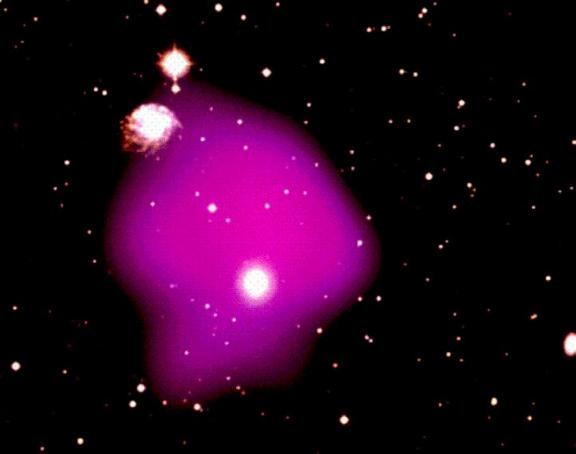 Why do we believe that dark matter exists? Because the gravity required to "hold onto" the materials inside galaxies and clusters of galaxies is much larger than the mass of visible objects. Above, an X-ray image of hot gas (shown in red) is superposed on an optical image of the cluster of galaxies which surrounds and presumably gravitationally contains the heated gases. But the visible mass of the galaxies is far too small to generate the gravity required to contain the gases, so some other source of gravity is required. That source, unseen and undetectable to date, is presumed to be dark matter, whose nature and abundance is as big a puzzle as its apparently immense mass. (Richard Mushotzky (GSFC/NASA), ROSAT, ESA, NASA, apod990404)
 A giant cluster of galaxies, CL0025+1654, 4.5 billion light-years away, is seen as it was when our Solar System was forming. The huge mass of the cluster bends light, as predicted by Einstein's theory of general relativity, forming a cosmic gravitational lens. Studying the bending of light (from more distant objects) passing through the cluster, leads to a map which shows the distribution of mass in the cluster. The total mass of the cluster is apparently much larger than the mass of the visible galaxies; but a surprising fact is made clear by the similarity between the distribution of mass, shown in blue, and the distribution of galaxies, shown in yellow. The two distributions are, within the accuracy of the observations, identical. In other words, although visible matter and "dark" matter have very different properties, they are distributed through space in the same way. Where there is a lot of visible matter, there is a lot of dark matter, and where there is very little visible matter, there is very little dark matter, as well. (J.-P. Kneib (Observatoire Midi-Pyrenees, Caltech) et al., ESA, NASA, apod030814)
 Abell 1689, a rich cluster of galaxies 2 billion light-years away, is one of the most massive "objects" in the Universe. The huge mass of the cluster so thoroughly warps the fabric of space-time that circular arcs which are distorted images of more distant galaxies fill the field of view. It is not the mass of the visible galaxies in the cluster, immense though it is, that bends the fabric of space-time in this way. Given the strength of the "lens" created by the cluster, it must have a mass a hundred times greater than that of its visible stars and galaxies. Immense quantities of "dark" matter must be scattered throughout the cluster. The nature of this dark matter is completely unknown, save for its reluctance to interact with light. (N. Benitez (JHU), T. Broadhurst (Hebrew Univ.), H. Ford (JHU), M. Clampin(STScI),
G. Hartig (STScI), G. Illingworth (UCO/Lick), ACS Science Team, ESA, NASA , apod030109)

3.4 billion light-years from Earth, two clusters of galaxies have collided and merged, to form the so-called "bullet cluster", 1E0657-56, shown here in a composite of three images. The galaxies in the clusters, shown in visible light, have mostly moved past each other, and are scattered across a relatively large region. Although disturbed and distorted by the gravitational pull of passing galaxies, the individual galaxies are more intact than not. On the other hand, gas spread throughout the clusters has collided with other gas, heated up and is now emitting intense X-radiation, shown in red. Based on the brightness of the X-radiation, the total mass of hot gas is substantially greater than the mass of the visible galaxies.
The overall distribution of mass in the cluster, as determined by gravitational lensing of distant galaxies, is shown in blue. The total mass much larger than the mass of the galaxies and hot gases combined. The excess mass, which is unobservable with any kind of radiation, is presumably "dark matter". The fact that the blue and red areas show little overlap indicates that like the galaxies, the dark matter interacts with itself and other materials only through gravity, and does not bunch up as a result of collisional shock waves, as the gas does. (X-ray: NASA/CXC/CfA/ M.Markevitch et al.; Lensing Map: NASA/STScI; ESO WFI; Magellan/U.Arizona/ D.Clowe et al.; Optical: NASA/STScI; Magellan/U.Arizona/D.Clowe et al.; apod060824) |